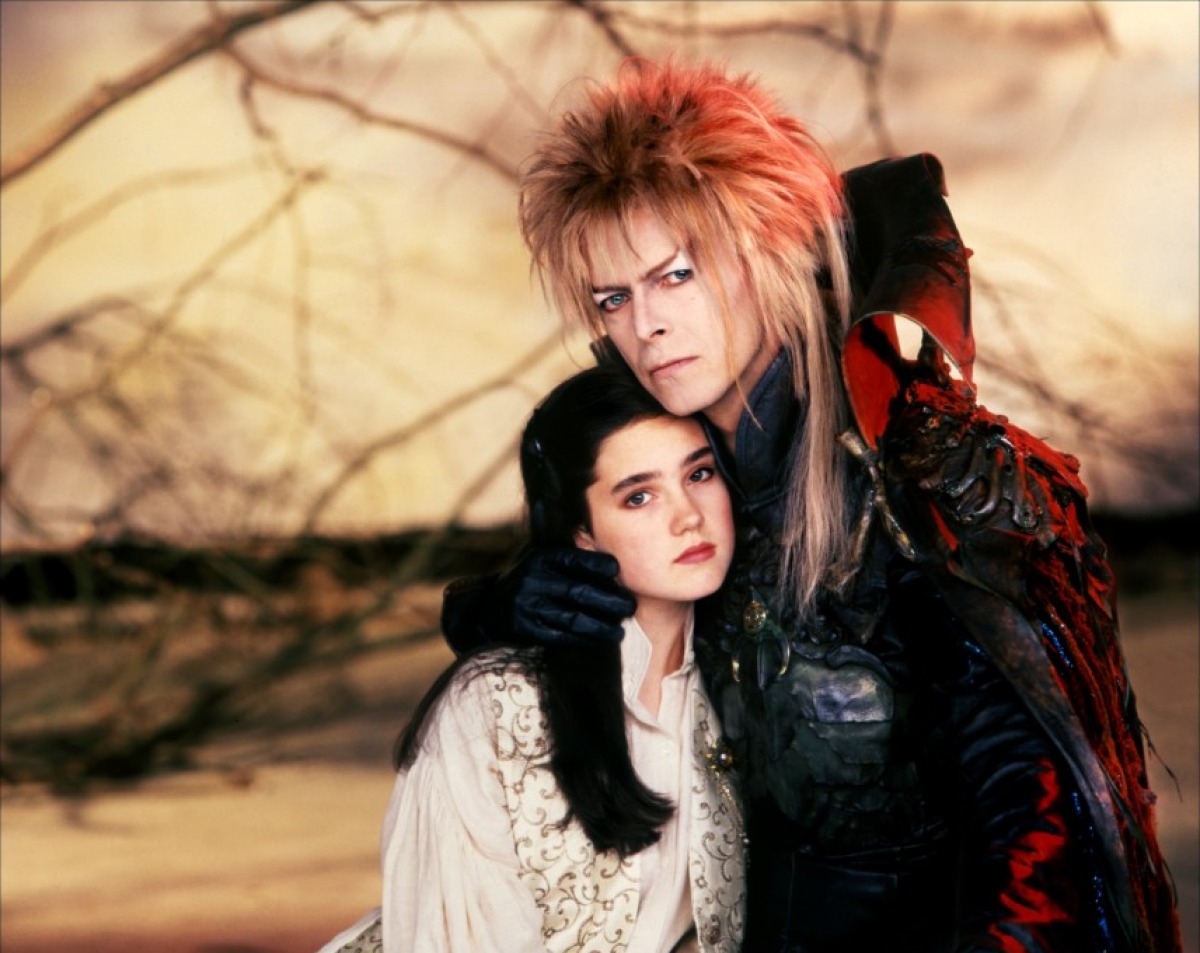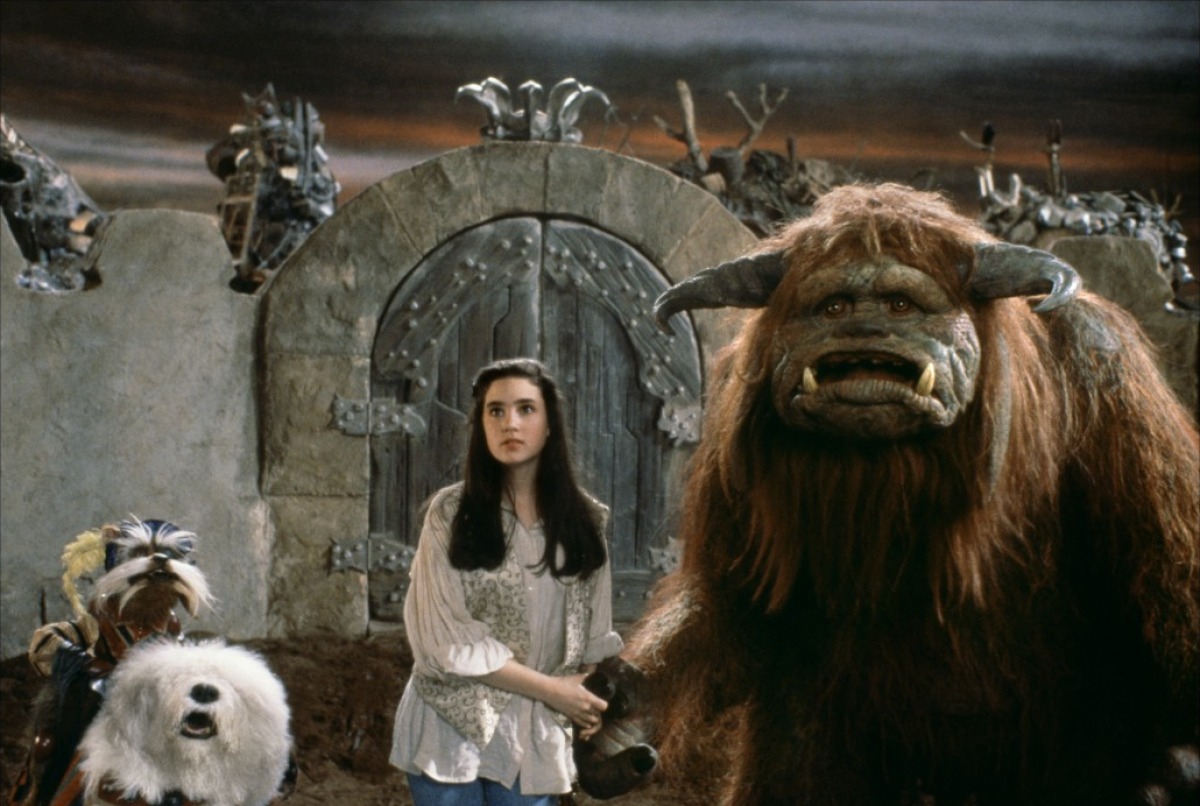USA. 1986.
Crew
Director – Jim Henson, Screenplay – Terry Jones, Story – Jim Henson & Denise Lee, Producer – Eric Rattray, Photography – Alex Thomson, Music – Trevor Jones, Songs – David Bowie, Visual Effects Supervisor – Roy Fields, Special Effects – Terry Ackland-Snow, Richard Conway, George Gibbs & Michael White, Puppets – Lyle Conway, Puppet Performers – Anthony Asbury, David Golez, Richard Hunt, Ron Mueck, Kathryn Muller, Jerry Nelson, Frank Oz, Shani Weisner & Steve Whitmire, Computer Animation – Digital Productions, Production Design – Elliott Scott. Production Company – Lucasfilm/Henson Associates
Cast
Jennifer Connelly (Sarah), David Bowie (Jareth)
Plot
Sarah is a young teenager who spends all her time dreaming of the world of fairy-tales. Resentful of her parents forcing her to look after her baby brother Toby, she wishes that the goblins would come and take Toby away. She is startled when the goblin king Jareth then appears and snatches Toby. Realising what she has done, she tries to get Toby back. Jareth agrees to a test – she can have Toby back if she solves the puzzles of his labyrinth within thirteen hours. Inside the labyrinth, Sarah finds a bewildering world of bizarre creatures, optical illusions, madcap logic, traps and, above all, Jareth’s treachery.
Jim Henson first emerged as a puppeteer on various regional tv series in the US during the 1950s and then found his fame creating characters for Sesame Street (1969– ). Of course, the work that Jim Henson will always be associated with is as the creator of The Muppet Show (1977-81). The Muppet Show was one of the great hit phenomena of the late 1970s/early 1980s, with the character of Miss Piggy even being accorded the status of a major star. The series was clever and slyly mocking, a puppet show on one hand, but also with a witty series of gags aimed over the heads of the kids at the adult audiences. Henson produced the first Muppet film, The Muppet Movie (1979), and then made his directorial debut with the second, The Great Muppet Caper (1981), both of which are delightful efforts.
From 1981 onwards, it became increasingly apparent that Jim Henson was seeking creative directions that went far beyond the simple hand and wire puppetry of the Muppets. It was with The Dark Crystal (1982), co-directed with his creative partner Frank Oz, that these new directions first became apparent. With The Dark Crystal, Jim Henson created an entire non-human world using not crude hand puppets but sophisticated marionettes, radio-controlled animatronics and full body-suit creations. The result was not just stunning technically but one of the few original screen creations of an entire self-contained fantasy otherworld. Labyrinth was Jim Henson’s successor to The Dark Crystal.
Labyrinth was a film where Jim Henson managed to array an extraordinary range of talents behind the camera – from his creative workshop team, to the film being made as a co-production with George Lucas, the director-writer of Star Wars (1977), and with a script from former Monty Python member Terry Jones, the director of all the Python cinematic outings and other fantasy ventures such as Erik the Viking (1989) and The Wind in the Willows (1996). Mostly though, Labyrinth is Jim Henson’s creation. Unfortunately, Henson died in 1990 of streptococcal pneumonia, depriving the world not merely of a great talent but someone who had just starting to blossom into their creative peak. Had Jim Henson not died, one is certain he would have gone onto even more remarkable things.

With Labyrinth, Jim Henson merges both puppetry and human actors in a state of the art step beyond anything he ever attempted before – here the puppetry has been taken to the extent of encasing actors inside animatronic bodysuits that have their facial features controlled by radio. The technical feat on display is stunning. Moreover, there is a genuinely eccentric, oddball charm to the conceptualisation of the film’s fabulous menagerie of creatures, which include Cockney-accented snails, talking bronze door knockers, living cannonballs and machine-guns, a double-door that handily comes together to form a giant steam-powered samurai, a breed of manic orange broomsticks that gleefully juggle their detachable bodily-parts and a truly amazing array of goblins.
The sets are an eye-catching array of optical illusions and sight gags, especially the goblin city of miniature houses, cobbled streets and awry angles, all concluding at the centre of the labyrinth, which is constructed as a three-dimensional depiction of an M.C. Escher painting. There is a dazzling and extraordinary breadth to the film’s creations that really needs a second viewing to take it all in. There is also an exquisitely beautiful opening credits sequence with a white owl flying back and forth, rippling a pool of water, that was one of the first entirely computer animated sequences designed for film.
What seems incomprehensible is the disdain that Labyrinth was treated with in in particular the US market where it did not do well with audiences and was critically trashed. The film certainly has some flaws. The story is on the slim side. Jim Henson’s use of fairy-tale quest as metaphorical journey into womanhood digs into some occasionally dark places, although the film had the edge taken off it somewhat by the more conceptually sophisticated The Company of Wolves (1984), which came out just as Labyrinth was going into production. (The film also one leaves one with an ending that muddies the metaphor for a final feelgood fadeout). The pace lags occasionally – the extended masque dream slows the middle of the film down.

Jennifer Connelly, then only sixteen years old and yet to go onto a career as an Oscar-winning actress, has a humourless wooden haughtiness about her and makes for a not particularly appealing lead. David Bowie can certainly be charismatic actor but this is a performance where he indulges himself with a theatricality that borders on the hammy. He also delivers two songs for the soundtrack.
Despite odd minor problems, Labyrinth is a beautiful film and there is something genuinely magical to it. Jim Henson maintains an almost perfect suspension of make-believe and Labyrinth should be well due critical re-evaluation as one of the major fantasy films of the 1980s.
George Lucas’s genre films as director have been the dystopian science-fiction film THX 1138 (1971); Star Wars (1977) and the Star Wars prequel trilogy Star Wars Episode I: The Phantom Menace (1999), Star Wars Episode II: Attack of the Clones (2002) and Star Wars Episode III: Revenge of the Sith (2005). George Lucas’s other genre works as producer are:– the Star Wars sequels The Empire Strikes Back (1980) and Return of the Jedi (1983), as well as various other animated series and spinoffs in the Star Wars universe; as producer of the Indiana Jones series consisting of Raiders of the Lost Ark (1981), Indiana Jones and the Temple of Doom (1984), Indiana Jones and the Last Crusade (1989), the tv series The Young Indiana Jones Chronicles (1992-3) and Indiana Jones and the Kingdom of the Crystal Skull (2008); the disastrous Howard the Duck (1986); the sword-and-sorcery adventure Willow (1988); and the animated Strange Magic (2015).
Trailer here


